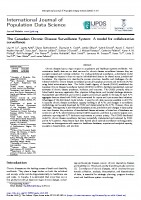Download
| File Size | 803.1 KiB |
|---|---|
| Date | October 15, 2018 |
| Downloads | 0 |
Authors: Lisa Lix, James Ayles, Sharon Bartholomew, Charmaine Cooke, Joellyn Ellison, Valerie Emond, Naomi Hamm, Heather Hannah, Sonia Jean, Shannon LeBlanc, J. Michael Paterson, Catherine Pelletier, Karen Phillips, Rolf Puchtinger, Kim Reimer, Cynthia Robitaille, Mark Smith, Lawrence Svenson, Karen Tu, Linda VanTil, Sean Waits, Louise Pelletier [Canadian Chronic Disease Surveillance System (CCDSS)]
The Canadian Chronic Disease Surveillance System (CCDSS) uses administrative data to estimate prevalence of multiple chronic diseases, including arthritis.
Chronic diseases have a major impact on populations and healthcare systems worldwide. Administrative health data are an ideal resource for chronic disease surveillance because they are population-based and routinely collected. For multi-jurisdictional surveillance, a distributed model is advantageous because it does not require individual-level data to be shared across jurisdictional boundaries. Our objective is to describe the process, structure, benefits, and challenges of a distributed model for chronic disease surveillance across all Canadian provinces and territories (P/Ts) using linked administrative data.
The Canadian Chronic Disease Surveillance System (CCDSS) uses administrative data to estimate prevalence of multiple chronic diseases, including arthritis.
Chronic diseases have a major impact on populations and healthcare systems worldwide. Administrative health data are an ideal resource for chronic disease surveillance because they are population-based and routinely collected. For multi-jurisdictional surveillance, a distributed model is advantageous because it does not require individual-level data to be shared across jurisdictional boundaries. Our objective is to describe the process, structure, benefits, and challenges of a distributed model for chronic disease surveillance across all Canadian provinces and territories (P/Ts) using linked administrative data.



